technical specifications FIAT PANDA 2014 319 / 3.G Owners Manual
[x] Cancel search | Manufacturer: FIAT, Model Year: 2014, Model line: PANDA, Model: FIAT PANDA 2014 319 / 3.GPages: 284, PDF Size: 11.54 MB
Page 106 of 284
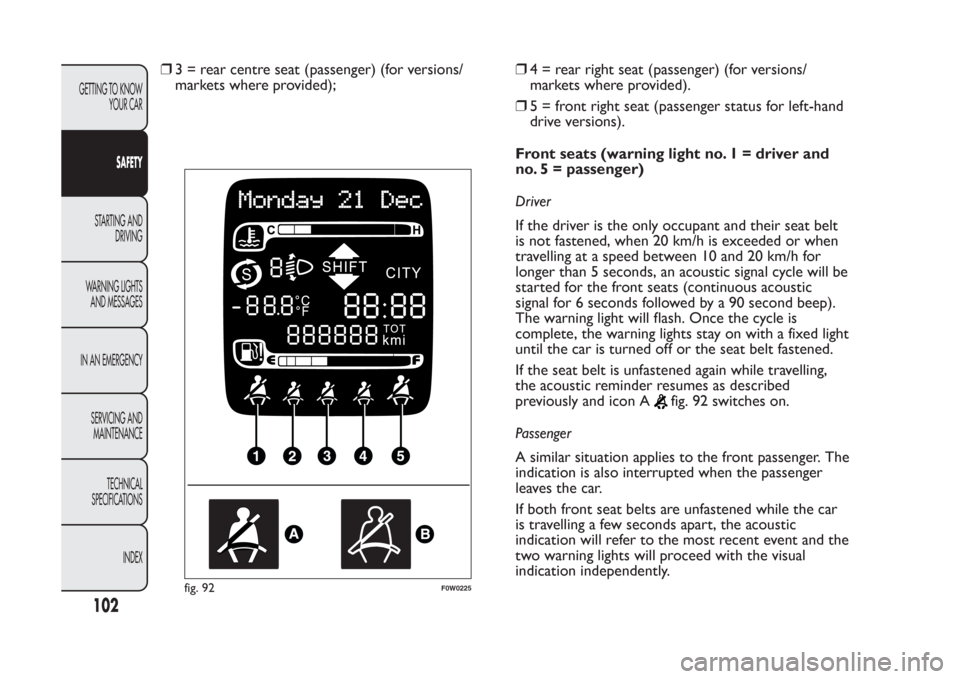
❒3 = rear centre seat (passenger) (for versions/
markets where provided);❒4 = rear right seat (passenger) (for versions/
markets where provided).
❒5 = front right seat (passenger status for left-hand
drive versions).
Front seats (warning light no. 1 = driver and
no. 5 = passenger)
Driver
If the driver is the only occupant and their seat belt
is not fastened, when 20 km/h is exceeded or when
travelling at a speed between 10 and 20 km/h for
longer than 5 seconds, an acoustic signal cycle will be
started for the front seats (continuous acoustic
signal for 6 seconds followed by a 90 second beep).
The warning light will flash. Once the cycle is
complete, the warning lights stay on with a fixed light
until the car is turned off or the seat belt fastened.
If the seat belt is unfastened again while travelling,
the acoustic reminder resumes as described
previously and icon A
fig. 92 switches on.
Passenger
A similar situation applies to the front passenger. The
indication is also interrupted when the passenger
leaves the car.
If both front seat belts are unfastened while the car
is travelling a few seconds apart, the acoustic
indication will refer to the most recent event and the
two warning lights will proceed with the visual
indication independently.
fig. 92
F0W0225
102
GETTING TO KNOW
YOUR CAR
SAFETY
STARTING AND
DRIVING
WARNING LIGHTS
AND MESSAGES
IN AN EMERGENCY
SERVICING AND
MAINTENANCE
TECHNICAL
SPECIFICATIONS
INDEX
Page 107 of 284
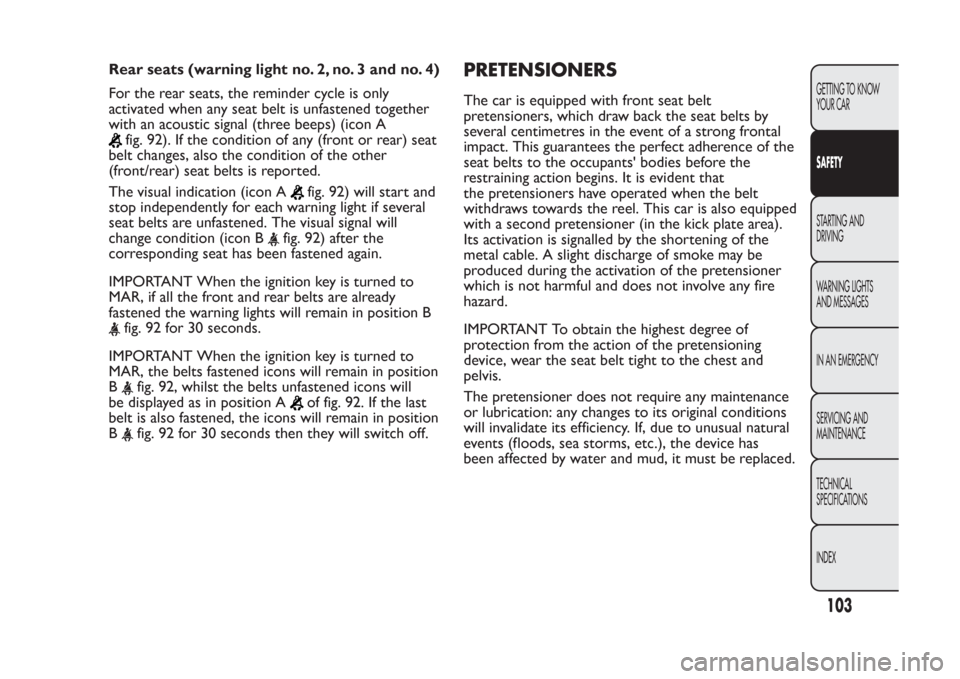
Rear seats (warning light no. 2, no. 3 and no. 4)
For the rear seats, the reminder cycle is only
activated when any seat belt is unfastened together
with an acoustic signal (three beeps) (icon A
fig. 92). If the condition of any (front or rear) seat
belt changes, also the condition of the other
(front/rear) seat belts is reported.
The visual indication (icon A
fig. 92) will start and
stop independently for each warning light if several
seat belts are unfastened. The visual signal will
change condition (icon B
fig. 92) after the
corresponding seat has been fastened again.
IMPORTANT When the ignition key is turned to
MAR, if all the front and rear belts are already
fastened the warning lights will remain in position B
fig. 92 for 30 seconds.
IMPORTANT When the ignition key is turned to
MAR, the belts fastened icons will remain in position
B
fig. 92, whilst the belts unfastened icons will
be displayed as in position A
of fig. 92. If the last
belt is also fastened, the icons will remain in position
B
fig. 92 for 30 seconds then they will switch off.
PRETENSIONERSThe car is equipped with front seat belt
pretensioners, which draw back the seat belts by
several centimetres in the event of a strong frontal
impact. This guarantees the perfect adherence of the
seat belts to the occupants' bodies before the
restraining action begins. It is evident that
the pretensioners have operated when the belt
withdraws towards the reel. This car is also equipped
with a second pretensioner (in the kick plate area).
Its activation is signalled by the shortening of the
metal cable. A slight discharge of smoke may be
produced during the activation of the pretensioner
which is not harmful and does not involve any fire
hazard.
IMPORTANT To obtain the highest degree of
protection from the action of the pretensioning
device, wear the seat belt tight to the chest and
pelvis.
The pretensioner does not require any maintenance
or lubrication: any changes to its original conditions
will invalidate its efficiency. If, due to unusual natural
events (floods, sea storms, etc.), the device has
been affected by water and mud, it must be replaced.
103GETTING TO KNOW
YOUR CARSAFETYSTARTING AND
DRIVING
WARNING LIGHTS
AND MESSAGES
IN AN EMERGENCY
SERVICING AND
MAINTENANCE
TECHNICAL
SPECIFICATIONS
INDEX
Page 108 of 284
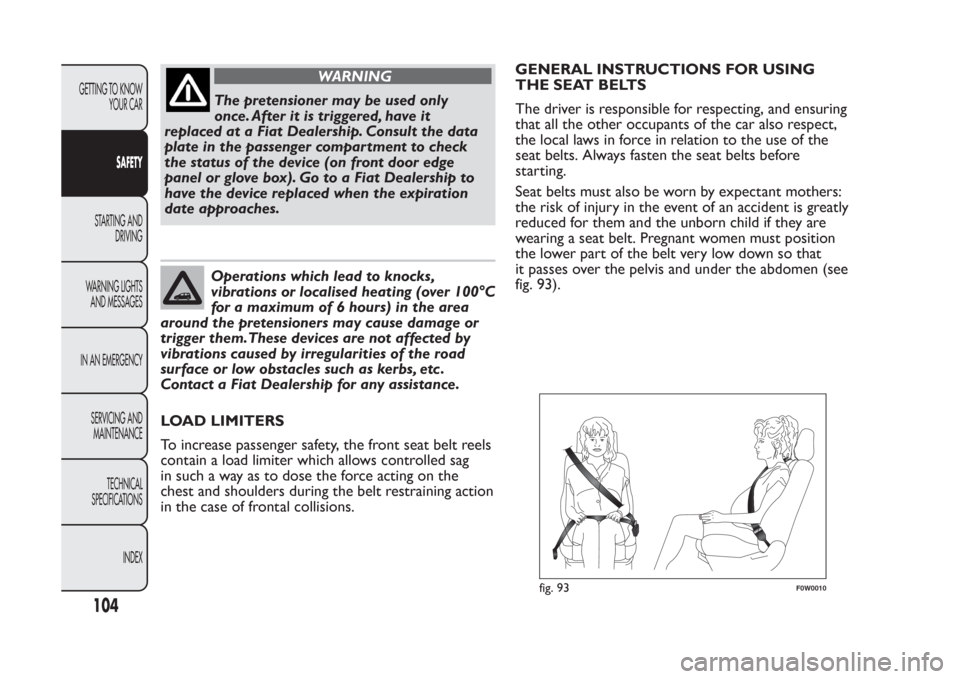
WARNING
The pretensioner may be used only
once. After it is triggered, have it
replaced at a Fiat Dealership. Consult the data
plate in the passenger compar tment to check
the status of the device (on front door edge
panel or glove box). Go to a Fiat Dealership to
have the device replaced when the expiration
date approaches.Operations which lead to knocks,
vibrations or localised heating (over 100°C
for a maximum of 6 hours) in the area
around the pretensioners may cause damage or
trigger them.These devices are not affected by
vibrations caused by irregularities of the road
surface or low obstacles such as kerbs, etc .
Contact a Fiat Dealership for any assistance.
LOAD LIMITERS
To increase passenger safety, the front seat belt reels
contain a load limiter which allows controlled sag
in such a way as to dose the force acting on the
chest and shoulders during the belt restraining action
in the case of frontal collisions.GENERAL INSTRUCTIONS FOR USING
THE SEAT BELTS
The driver is responsible for respecting, and ensuring
that all the other occupants of the car also respect,
the local laws in force in relation to the use of the
seat belts. Always fasten the seat belts before
starting.
Seat belts must also be worn by expectant mothers:
the risk of injury in the event of an accident is greatly
reduced for them and the unborn child if they are
wearing a seat belt. Pregnant women must position
the lower part of the belt very low down so that
it passes over the pelvis and under the abdomen (see
fig. 93).
fig. 93
F0W0010
104
GETTING TO KNOW
YOUR CAR
SAFETY
STARTING AND
DRIVING
WARNING LIGHTS
AND MESSAGES
IN AN EMERGENCY
SERVICING AND
MAINTENANCE
TECHNICAL
SPECIFICATIONS
INDEX
Page 109 of 284
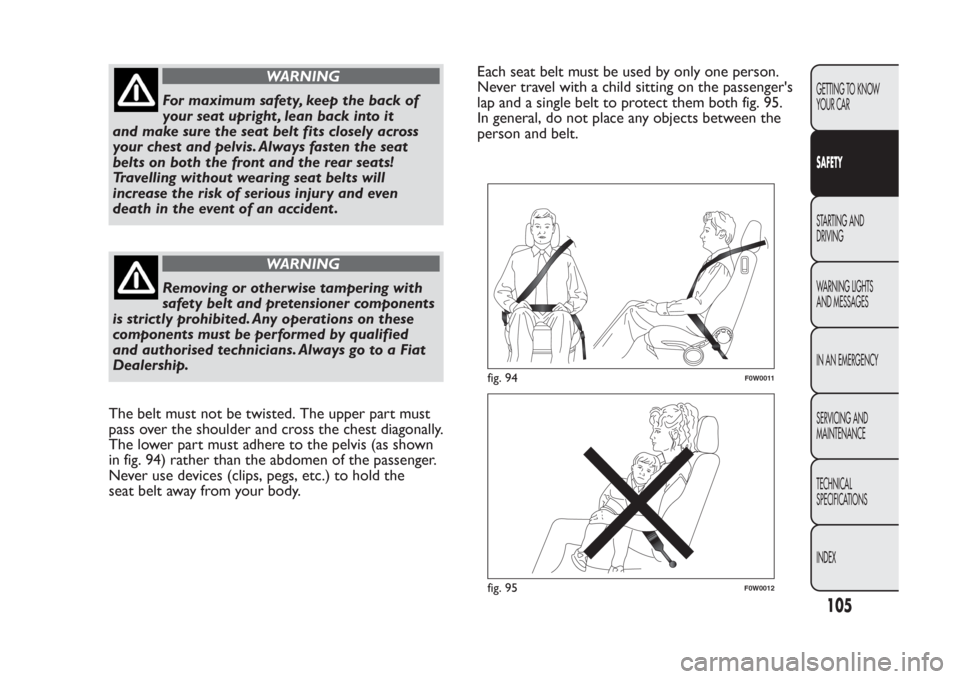
WARNING
For maximum safety, keep the back of
your seat upright , lean back into it
and make sure the seat belt fits closely across
your chest and pelvis. Always fasten the seat
belts on both the front and the rear seats!
Travelling without wearing seat belts will
increase the risk of serious injur y and even
death in the event of an accident .
WARNING
Removing or otherwise tampering with
safety belt and pretensioner components
is strictly prohibited. Any operations on these
components must be performed by qualified
and authorised technicians. Always go to a Fiat
Dealership.
The belt must not be twisted. The upper part must
pass over the shoulder and cross the chest diagonally.
The lower part must adhere to the pelvis (as shown
in fig. 94) rather than the abdomen of the passenger.
Never use devices (clips, pegs, etc.) to hold the
seat belt away from your body.Each seat belt must be used by only one person.
Never travel with a child sitting on the passenger's
lap and a single belt to protect them both fig. 95.
In general, do not place any objects between the
person and belt.
fig. 94
F0W0011
fig. 95
F0W0012
105GETTING TO KNOW
YOUR CARSAFETYSTARTING AND
DRIVING
WARNING LIGHTS
AND MESSAGES
IN AN EMERGENCY
SERVICING AND
MAINTENANCE
TECHNICAL
SPECIFICATIONS
INDEX
Page 110 of 284
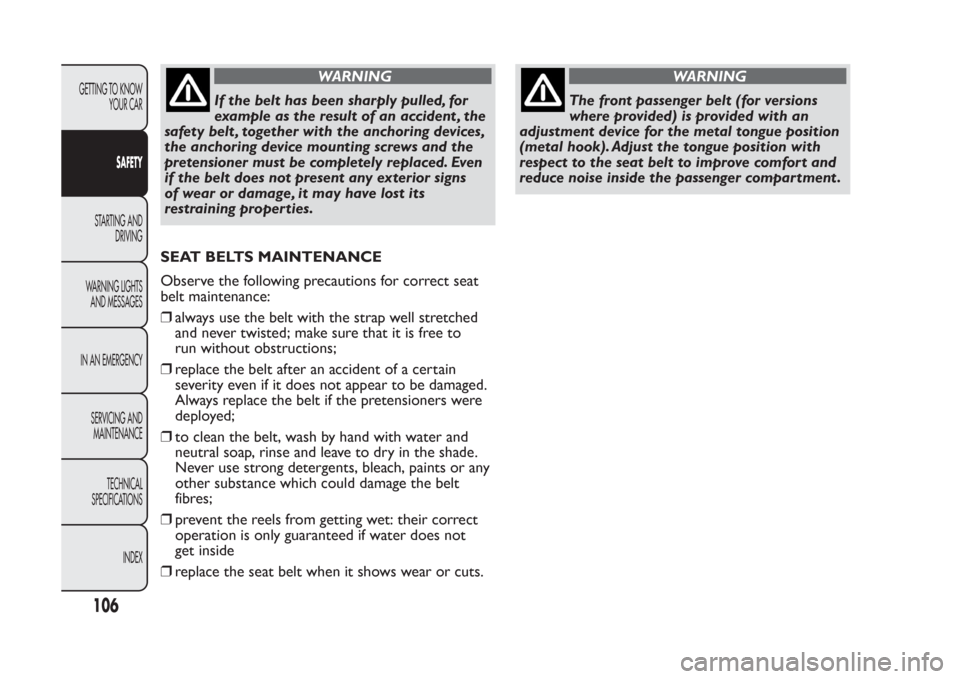
WARNING
If the belt has been sharply pulled, for
example as the result of an accident , the
safety belt , together with the anchoring devices,
the anchoring device mounting screws and the
pretensioner must be completely replaced. Even
if the belt does not present any exterior signs
of wear or damage, it may have lost its
restraining properties.
SEAT BELTS MAINTENANCE
Observe the following precautions for correct seat
belt maintenance:
❒always use the belt with the strap well stretched
and never twisted; make sure that it is free to
run without obstructions;
❒replace the belt after an accident of a certain
severity even if it does not appear to be damaged.
Always replace the belt if the pretensioners were
deployed;
❒to clean the belt, wash by hand with water and
neutral soap, rinse and leave to dry in the shade.
Never use strong detergents, bleach, paints or any
other substance which could damage the belt
fibres;
❒prevent the reels from getting wet: their correct
operation is only guaranteed if water does not
get inside
❒replace the seat belt when it shows wear or cuts.
WARNING
The front passenger belt (for versions
where provided) is provided with an
adjustment device for the metal tongue position
(metal hook). Adjust the tongue position with
respect to the seat belt to improve comfor t and
reduce noise inside the passenger compar tment .
106
GETTING TO KNOW
YOUR CAR
SAFETY
STARTING AND
DRIVING
WARNING LIGHTS
AND MESSAGES
IN AN EMERGENCY
SERVICING AND
MAINTENANCE
TECHNICAL
SPECIFICATIONS
INDEX
Page 111 of 284
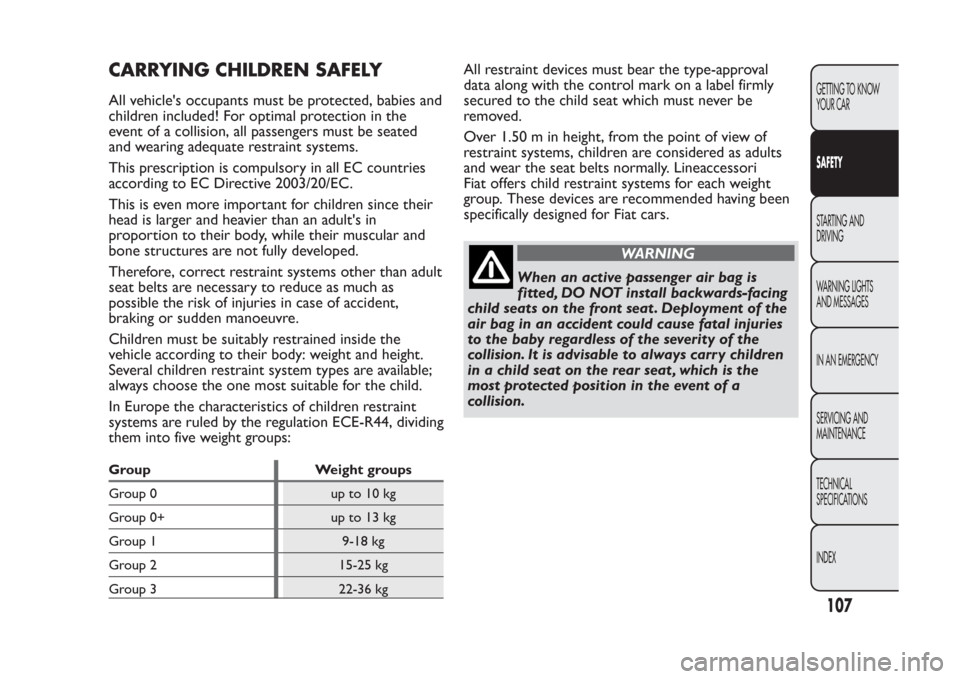
CARRYING CHILDREN SAFELYAll vehicle's occupants must be protected, babies and
children included! For optimal protection in the
event of a collision, all passengers must be seated
and wearing adequate restraint systems.
This prescription is compulsory in all EC countries
according to EC Directive 2003/20/EC.
This is even more important for children since their
head is larger and heavier than an adult's in
proportion to their body, while their muscular and
bone structures are not fully developed.
Therefore, correct restraint systems other than adult
seat belts are necessary to reduce as much as
possible the risk of injuries in case of accident,
braking or sudden manoeuvre.
Children must be suitably restrained inside the
vehicle according to their body: weight and height.
Several children restraint system types are available;
always choose the one most suitable for the child.
In Europe the characteristics of children restraint
systems are ruled by the regulation ECE-R44, dividing
them into five weight groups:Group Weight groups
Group0 upto10kg
Group 0+ up to 13 kg
Group 1 9-18 kg
Group 2 15-25 kg
Group 3 22-36 kg
All restraint devices must bear the type-approval
data along with the control mark on a label firmly
secured to the child seat which must never be
removed.
Over 1.50 m in height, from the point of view of
restraint systems, children are considered as adults
and wear the seat belts normally. Lineaccessori
Fiat offers child restraint systems for each weight
group. These devices are recommended having been
specifically designed for Fiat cars.
WARNING
When an active passenger air bag is
fitted, DO NOT install backwards-facing
child seats on the front seat . Deployment of the
air bag in an accident could cause fatal injuries
to the baby regardless of the severity of the
collision. It is advisable to always carr y children
in a child seat on the rear seat , which is the
most protected position in the event of a
collision.
107GETTING TO KNOW
YOUR CARSAFETYSTARTING AND
DRIVING
WARNING LIGHTS
AND MESSAGES
IN AN EMERGENCY
SERVICING AND
MAINTENANCE
TECHNICAL
SPECIFICATIONS
INDEX
Page 112 of 284
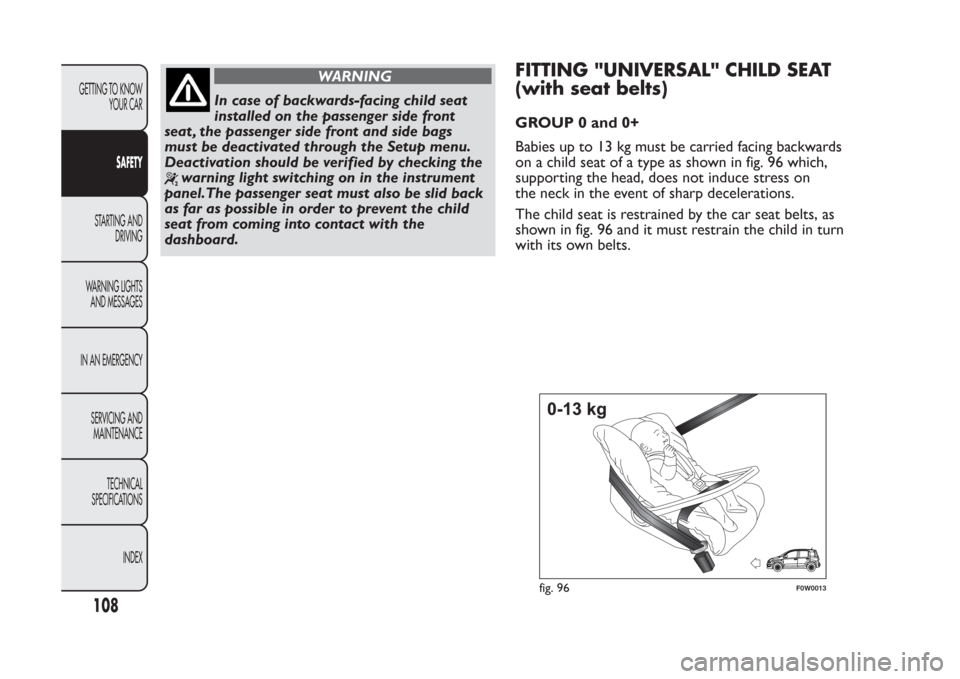
WARNING
In case of backwards-facing child seat
installed on the passenger side front
seat , the passenger side front and side bags
must be deactivated through the Setup menu.
Deactivation should be verified by checking the
warning light switching on in the instrument
panel.The passenger seat must also be slid back
as far as possible in order to prevent the child
seat from coming into contact with the
dashboard.
FITTING "UNIVERSAL" CHILD SEAT
(with seat belts)GROUP 0 and 0+
Babies up to 13 kg must be carried facing backwards
on a child seat of a type as shown in fig. 96 which,
supporting the head, does not induce stress on
the neck in the event of sharp decelerations.
The child seat is restrained by the car seat belts, as
shown in fig. 96 and it must restrain the child in turn
with its own belts.
fig. 96
F0W0013
108
GETTING TO KNOW
YOUR CAR
SAFETY
STARTING AND
DRIVING
WARNING LIGHTS
AND MESSAGES
IN AN EMERGENCY
SERVICING AND
MAINTENANCE
TECHNICAL
SPECIFICATIONS
INDEX
Page 113 of 284
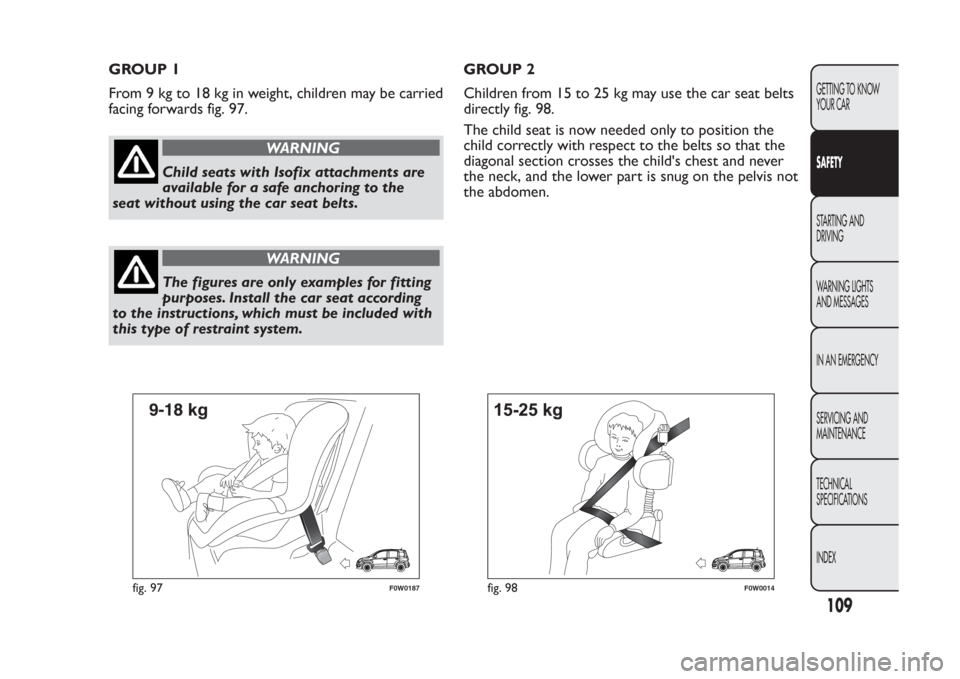
GROUP 1
From 9 kg to 18 kg in weight, children may be carried
facing forwards fig. 97.
WARNING
Child seats with Isofix attachments are
available for a safe anchoring to the
seat without using the car seat belts.
WARNING
The figures are only examples for fitting
purposes. Install the car seat according
to the instructions, which must be included with
this type of restraint system.GROUP 2
Children from 15 to 25 kg may use the car seat belts
directly fig. 98.
The child seat is now needed only to position the
child correctly with respect to the belts so that the
diagonal section crosses the child's chest and never
the neck, and the lower part is snug on the pelvis not
the abdomen.
fig. 97
F0W0187
fig. 98
F0W0014
109GETTING TO KNOW
YOUR CARSAFETYSTARTING AND
DRIVING
WARNING LIGHTS
AND MESSAGES
IN AN EMERGENCY
SERVICING AND
MAINTENANCE
TECHNICAL
SPECIFICATIONS
INDEX
Page 114 of 284

GROUP 3
For children from 22 kg up to 36 kg suitable risers
are available to position the seat belt correctly.
The fig. 99 shows an example of correct child seat
positioning on the rear seat.
Children over 1.50 m in height wear seat belts like
adults.
WARNING
The figures are only examples for fitting
purposes. Install the car seat according
to the instructions, which must be included with
this type of restraint system.
fig. 99
F0W0015
110
GETTING TO KNOW
YOUR CAR
SAFETY
STARTING AND
DRIVING
WARNING LIGHTS
AND MESSAGES
IN AN EMERGENCY
SERVICING AND
MAINTENANCE
TECHNICAL
SPECIFICATIONS
INDEX
Page 115 of 284
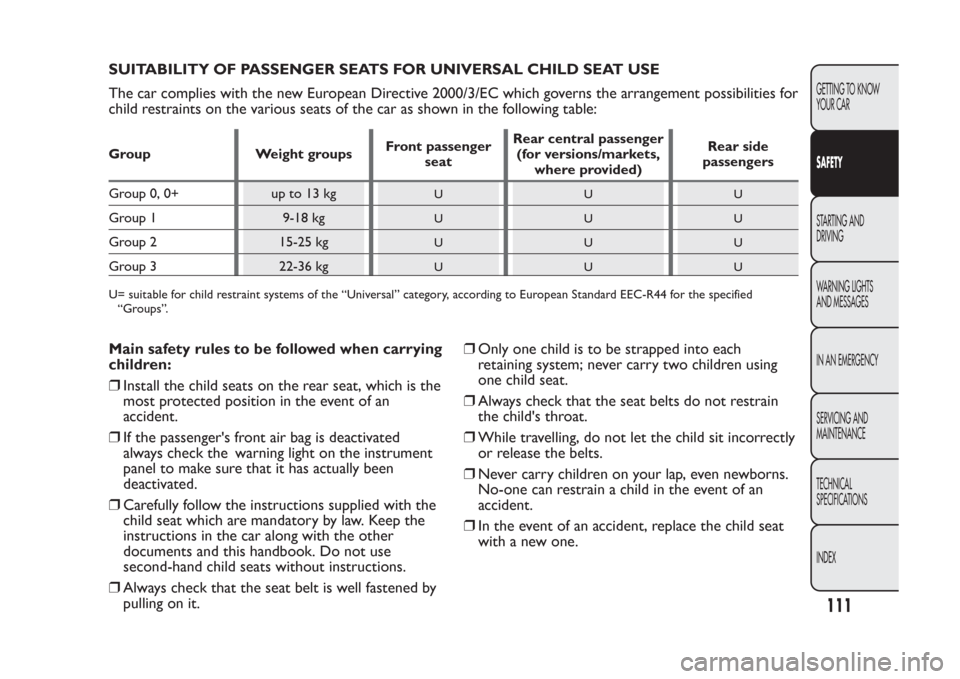
SUITABILITY OF PASSENGER SEATS FOR UNIVERSAL CHILD SEAT USE
The car complies with the new European Directive 2000/3/EC which governs the arrangement possibilities for
child restraints on the various seats of the car as shown in the following table:Group Weight groupsFront passenger
seatRear central passenger
(for versions/markets,
where provided)Rear side
passengers
Group 0, 0+ up to 13 kg
UUU
Group 1 9-18 kg
UUU
Group 2 15-25 kg
UUU
Group 3 22-36 kg
UUU
U= suitable for child restraint systems of the “Universal” category, according to European Standard EEC-R44 for the specified
“Groups”.
Main safety rules to be followed when carrying
children:
❒Install the child seats on the rear seat, which is the
most protected position in the event of an
accident.
❒If the passenger's front air bag is deactivated
always check the warning light on the instrument
panel to make sure that it has actually been
deactivated.
❒Carefully follow the instructions supplied with the
child seat which are mandatory by law. Keep the
instructions in the car along with the other
documents and this handbook. Do not use
second-hand child seats without instructions.
❒Always check that the seat belt is well fastened by
pulling on it.❒Only one child is to be strapped into each
retaining system; never carry two children using
one child seat.
❒Always check that the seat belts do not restrain
the child's throat.
❒While travelling, do not let the child sit incorrectly
or release the belts.
❒Never carry children on your lap, even newborns.
No-one can restrain a child in the event of an
accident.
❒In the event of an accident, replace the child seat
with a new one.
111GETTING TO KNOW
YOUR CARSAFETYSTARTING AND
DRIVING
WARNING LIGHTS
AND MESSAGES
IN AN EMERGENCY
SERVICING AND
MAINTENANCE
TECHNICAL
SPECIFICATIONS
INDEX